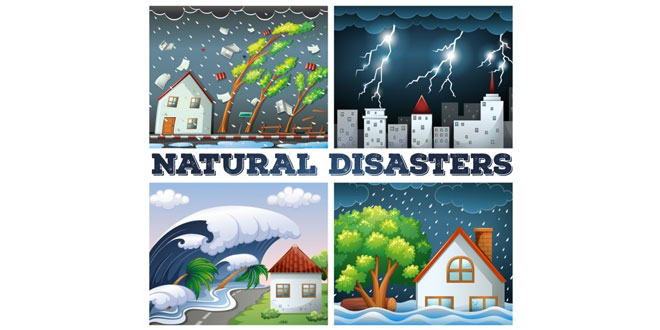Question: What precautions are needed in cyclone-affected areas?
Answer: Precautions against Cyclones:
- Listen regularly to weather bulletins on television and radio.
- Keep an emergency kit ready at home.
- Secure your home or move to a safer place before the cyclone hits your area.
- Store enough non-perishable food articles in waterproof bags.
- Do not venture into the sea.
- Keep phone numbers of hospitals, police, help agencies, relatives and friends handy.
- After the cyclone, check gas leaks and dry the electrical appliances.
- Avoid floodwater and be careful about snake bites.
Question: What precautions are taken against floods?
Answer: Precautions against Floods:
- Know the routes and locations of safe shelters.
- Listen to the radio or watch television for warning and advice.
- Keep the first aid kit ready, especially for diarrhoea and snake bites.
- Keep strong ropes for tying things.
- Keep a radio, torch, matchbox, candles and spare batteries.
- Keep adequate stock of freshwater, food articles and kerosene.
- Keep waterproof bags for packing food articles and clothes.
- Keep bamboo sticks to ward off snakes.
- Do not enter the flooded areas of unknown depth.
- Switch off power and electrical appliances.
- Drink only boiled water and eat only fresh cooked food.
- Take help from disaster management teams and other agencies.
Question: Discuss the precautionary measures you will take in tsunami-prone areas.
Answer: Precautions against Tsunamis:
- If you experience an earthquake that lasts for about 20 seconds or longer when you happen to be in a coastal area, move to higher ground immediately after the shaking stops.
- In some cases, the sea water may recede upto 800 m from the coast. Do not enter this temporary dry area, as the sea water may come back soon.
- Know the height of your street above sea level and the distance from the coast. The areas of great risk are less than 10 m above sea level and within two km from the coast.
- Prepare a plan of the evacuation route from your house, school or workplace and find an area about 30 m above sea level. You should be able to reach a safe location in 15 minutes.
- The tsunami warning systems should be installed in high-risk zones.
- If you are visiting a place in the high-risk zone, check with the hotel or tour operators about tsunami evacuation information and how you would be warned about it.
- Discuss tsunami with your family a this will help reduce the fear and anxiety associated with it.
 Class Notes NCERT Solutions for CBSE Students
Class Notes NCERT Solutions for CBSE Students


